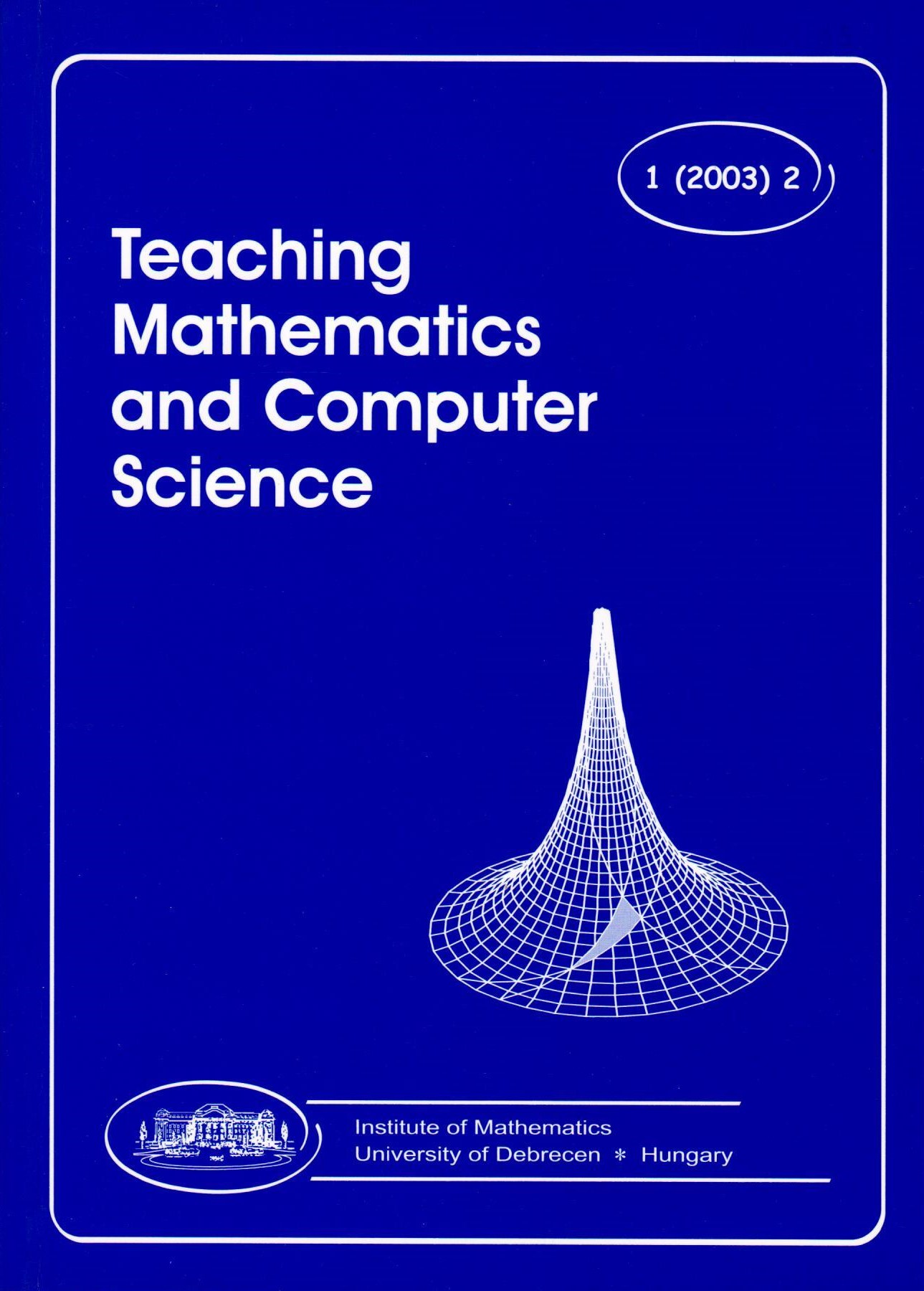Vol. 1 No. 2 (2003)
Published
2003 December 1
##issue.tableOfContents##
Articles
-
Beweise von Sätzen mit Hilfe der Modelle der hyperbolischen Geometrie
159-167Views:70We give simple proofs for some problems of elemental hyperbolic geometry using the Poincare's half-sphere model. Our method is that a point of a figure is transformed to a special point of the model.PDF (German)38 -
On the legacy of G. Pólya: some new (old) aspects of mathematical problem solving and relations to teaching
169-189Views:94In this article are given some new aspects of mathematical problem solving. A framework is presented by three main resources: (1) Pólya's studies about mathematical heuristics are augmented by information drawn from a study of the history of mathematical problem solving. (2) Connections are presented between mathematical problem solving and mathematical beliefs. (3) Experience with a special program for mathematical talented students is sketched. On this background a new textbook-series has been developed and some teaching examples are taken from this context. An outlook is given on some new research on teaching of problem solving, including possible relations to modern brain research.PDF58 -
A KöMaL problem in a new view
191-201Views:52The object of this paper is finding the general solution f : R^3 → R of the system of functional equations (1) valid for all x, y, z, t ϵ R. First f is expressed by a function of one variable which satisfies a system of two functional equations.This system is resolved by using an algebraic reformulation of the problem in terms of orbits and transversals. Finally the general solution of (1) is obtained.PDF98 -
The Frobenius exchange problem on competitions and in classroom
203-218Views:38Let a_1, ..., a_n be relatively prime positive integers. The still unsolved Frobenius problem asks for the largest integer which cannot be represented as Σ x_i a_i with non-negative integers xi, and also for the number of non-representable positive integers. These and several related questions have been investigated by many prominent mathematicians, including Paul Erdős, and a wide range of partial results were obtained by various interesting methods differing both in character and difficulty. In this paper we give a self-contained introduction to this field through problems and comments suitable also for treatment in a class of talented students.PDF140 -
Two centuries of the equations of commutativity and associativity of exponentiation
219-233Views:61In this survey article we guide the reader through the solution of the commutative equation of exponentiation x^y = y^x and that of the associative equation of exponentiation x^(y^z) = (x^y)^z. Various characterizations of the integer, rational, real and complex solutions are discussed together with some new results and open directions. The article is supplemented by a detailed and commented bibliography on the history of these equations.PDF88 -
Un point d'heuristique important et mal connu: la particularisation
235-245Views:107Cet article est consacré á la présentation d'un point d'heuristique d'une grande importance et sur lequel on insiste trés peu dans notre enseignement. C'est donc une cause fréquente d'échec pour de nombreux éléves. Il s'agit du procédé consistant á particulariser lorsqu'on dispose d'une hypothése dont l'énoncé commence par "quel que soit...". Plusieurs exemples dans divers domaines des mathématiques sont proposés.
This article is devoted to the presentation of a point of heuristics of a great importance, and on which we do not lay much emphasis in our teaching. Then, it is a frequent cause of failure for many pupils. It concerns the followings process: to particularize when we dispose of an hypothesis that begins "For any...". Several examples in various domains of mathematics are proposed.PDF (French)31 -
Methods of teaching programming
247-257Views:106Programming methodology is one of the oldest fields of IS education, and thus various methods have evolved for its teaching. While some of them could be used effectively in primary or secondary education, others are more suited for students in higher education. The methods themselves determine the structure and curricula of courses such as Programming methodology, Data types and algorithms, Programming technology.PDF53 -
Report on "The Computer Algebra and Dynamical Geometry Systems, as the catalysts of the Mathematics education": Conference, 6-7 June, 2003, Pécs, Hungary
259-269Views:64The Department of Mathematics of the University of Pécs, Pollack Mihály Engineering Faculty organized in the year 2003 a conference on the role of CAS and DGS in the Mathematics education. We discuss – based on the authors' abstracts – the conference's activities.PDF93 -
From iteration to one - dimensional discrete dynamical systems using CAS
271-296Views:79In our paper we present the basic didactical framework and approaches of a course on one-dimensional discrete dynamical systems made with the help of Computer Algebra Systems (CAS) for students familiar with the fundamentals of calculus. First we review some didactical principles of teaching mathematics in general and write about the advantages of the modularization for CAS in referring to the constructivistic view of learning. Then we deal with our own development, a CAS-based collection of programs for teaching Newton's method for the calculation of roots of a real function. Included is the discussion of domains of attraction and chaotic behaviour of the iterations. We summarize our teaching experiences using CAS.PDF34 -
Experimentieren um einen Satz zu finden - vollständig separierbare Mosaike auf der Kugel und ihre Anwendungen
297-319Views:85This paper reports a case-study which took place within the project named "Inner differentiation and individualization by creating prototypes and analogies under consideration of motivational constraints (taking into account computer-based teaching and learning)" as a part of a pre-service teacher training at the University of Salzburg (Herber, H.-J. & Vásárhelyi, É.).
The goal of the experiment was to help students to learn the fundamental concepts and basic constructions of spherical geometry using the Lénárt Sphere (a transparent plastic ball with construction-tools) and some self-made interactive worksheets with the Windows version of the dynamical geometry software Cabri.PDF (German)57 -
Assimilation of mathematical knowledge using Maple
321-331Views:107For more than four years we have been teaching a Maple course at University of Debrecen for prospective mathematics teachers. The aim of the course is that students get some experience on mathematical visualization with Maple. At the last part of the course the student is provided with a problem of geometrical flavor. Within three or four weeks he/she must obtain a solution. In this paper we present and analyze two of student projects: rotation of the hypercube and drawing of complex functions. The concluding remark is that most of the students will profit from using Maple for such type of problems: it helps to assimilate mathematical knowledge.PDF50 -
Models of impulsive phenomena: experiences with writing an interactive textbook
333-345Views:85"Take the textbook to computer" – is said quite often. Would it be so easy? If we start such a work, we meet a lot of trouble very soon. A book stored on a CD, read on the screen of computer and containing some hyperlinks does not become automatically electronic textbook. There are difficulties also in writing merely an electronic attachment to a classical book. In this paper, we deal with some important features (actually important from our point of view) of interactive mathematics textbooks, arising mathematical, didactical and technical problems. The "principles" are illustrated with examples taken from the book-CD "Models of Impulsive Phenomena".PDF37 -
Interactive web portals in mathematics
347-361Views:186Many of the recent problems in higher education (less contact seminars, the heterogeneity and the increasing number of our students) call for new instructional methods. At University of Szeged we have developed a mathematical web portal which can offer a solution for such problems among the changing circumstances. This freely available, easy-to-use web-surface supports interactive mathematical problem-solving and student self assessment. Our computer program cooperates with a lot of free software (computer algebra systems, formula parsers, converters, word processors). WebMathematics Interactive has been available for the public since June 2002 on its web page http://wmi.math.u-szeged.hu.PDF77 -
Experiences using CAS and multimedia int teaching vectorcalculus
363-382Views:74The development of informatics brings new opportunities that need reevaluating of the teaching concepts. For this reason we have performed a comprehensive educational development for engineering students. Our main goals were to work out a new educational strategy, to develop the needed package of the subject material, to introduce the strategy in the practice, to analyze and evaluate the experiences. In the developed and adapted teaching-learning strategy the teacher is the organizer, designer and the manager of the process. In this paper we summarize the concepts, the results and experiences of the 3-years-long development.PDF49 -
Illustrated analysis of Rule of Four using Maple
383-404Views:101Rule of Four, as a basic didactic principle, was formulated among the NCTM 2000 standards (see [14]) and since then it is quoted by numerous books and publications (see [4], [9], [12]). Practically we can say it is accepted by the community of didactic experts. The usage of the Rule of Four, however, has been realized mainly in the field of calculus, in fact certain authors restrict the wording of the principle to the calculus itself (e.g. [3]).
Calculus is a pleasant field, indeed. A sequence of values of a function provides us with example for numeric representation, while the formula and the graph of the function illustrate symbolic and graphical representations, respectively. In the end by wording the basic features of the function on natural language we gain textual representation.
This idyllic scene, however, becomes more complex when we leave the frame of calculus. In this paper we investigate the consequences of the usage of Rule of Four outside calculus. We discuss the different types of representations and show several examples which make the multiple features of representation evident. The examples are from different fields of mathematics and are created by the computer algebra system Maple, which turns out to be an excellent tool for illustration and visualization of the maim features of mathematical objects.
Next we introduce the concept of basic representation and rational representation, which is considered as the mathematical notion of "didactic usable" or "didactic rational" representation. In the end we generalize the notion of numeric representation, which leads us a more widely usable didactic principle which can be considered as a generalization of Rule of Four.PDF60 -
Problem-solving in mathematics with the help of computers
405-422Views:84One of the most important tasks of the didactics of mathematics is the describing of the process of problem-solving activity and problem-solving thinking. The psychological theories concerning the problem-solving thinking leave the special demand of school subjects out of consideration, and search for connections of universal validity. In this article we attempt to connect an abstract theory of psychology concerning problem-solving thinking and a more practical conception of the problem-solving activity of mathematics, which is based on Polya's idea. In this way we can get a structure of problem-solving, which has scientific bases and at the same time it is useful in computer aided learning. Our result was developed and tested in Hungary so this is suitable especially for the Hungarian conditions of mathematics teaching.PDF40
Keywords
Issues by Year
2020
2017
2011
2010
2009
2007
2006
2005
2004
2003







